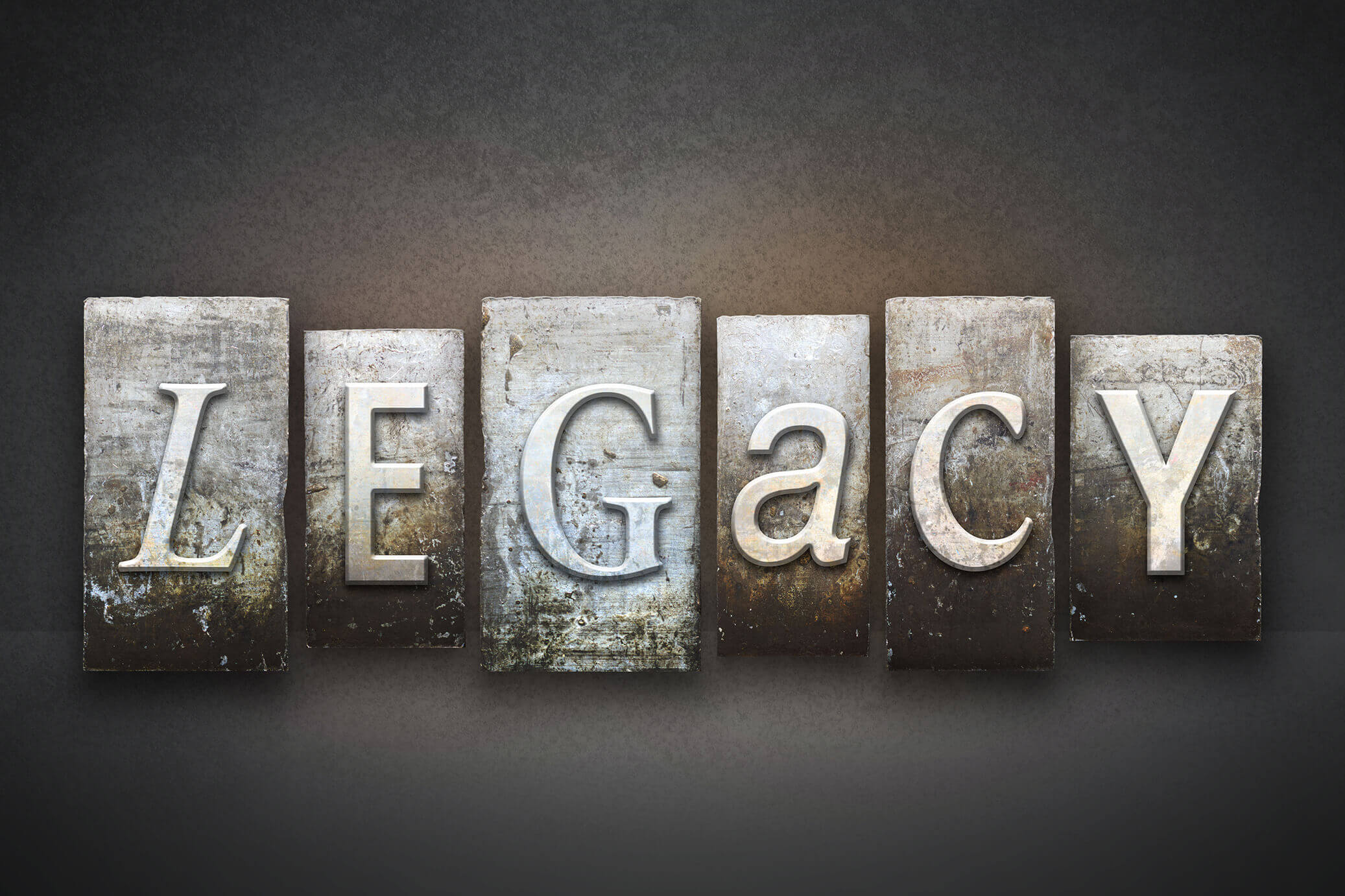There’s a quote attributed to Confucius that says, “We have two lives, and the second begins when we realize we only have one.”
It’s oh-so-true — and it’s that second life where most people start to think about leaving a legacy. Whether it’s leaving a legacy for your family, building an organization that outlasts you, writing the book that shapes thinking for centuries to come … legacy is a way of “passing on the essence of one’s self, in particular one’s values and beliefs. Legacy is a method of leaving something behind after death and making meaning of the end of life.” (Journal of Death and Dying)
It’s a natural human impulse to want to leave a mark. And it’s equally human to have no idea how to go about doing so. So let’s break it down.
Four foundational concepts for legacy-building:
Like we said, it’s only human to want to leave a legacy. But while the impulse is the same, the underlying reasons people want to leave a legacy can be very, very different.
For one person, it might be that they care about their children having good memories of a happy home and a loving, nurturing relationship with them that lasts even when they’re gone. As long as that’s taken care of, they’re happy.
For someone else, it might be that they won’t feel like they’ve done what they came here to do unless they leave something tangible behind, whether that’s a building, a business, a home for someone, a book … something people can pick up or touch or be involved with after they’re gone. Others don’t really care at all about any of that kind of thing, but are more interested in leaving a legacy of values — that is, having a positive impact on the world around them and passing down an experience and tradition of the values they care about.
This third category has actually been found to be the most important by researchers Elizabeth Hunter and Graham Rowles:
“A typology of three distinct but overlapping categories of legacy was identified: biological legacy, material legacy and a legacy of values. Sub-types were identified within each category. Each participant clearly articulated and identified with at least one form of legacy and the majority expressed all three types but with varying degrees of intensity and with the legacy of values viewed as more important than other forms of legacy.”
Regardless of which is most important to you as you consider your legacy, it’s crucial that you get clear on that underlying motivation — that’s what will keep you on track and motivated as you’re in the active stages of legacy-building. Of course, these three categories aren’t mutually exclusive, your motivations may overlap. But there’s usually a core reason that the others cluster around. Get clear on yours, and that whole question of “What legacy will you leave” gets way easier.
Finding your legacy in how you live
All of that sounds great. But when push comes to shove, how do you decide what legacy you want to leave after you’re gone? The answer lies in what you’re meant to do while you’re alive. This may sound counter-intuitive, but think about it this way: it’s your legacy. It has to come from that core version of yourself, that which is most important to you. This also helps you avoid the trap that GLP podcast guest Rabbi Steve Leder calls idolatry, where we center something we think we should want, like money, or a reputation, or somebody else’s idea of success, and we “make it a part of our identity and definition of success. Then we end up devoting so many of our lives to attaining the symbol. And then we wonder why we don’t feel the way we want to feel.”
So take some time to get clear on your reason for being –– this article on how to figure out what to do with your life can help, as can the Sparketype Assessment, which is designed to give you a sense of what your unique “fingerprint” for the kind of work you’re here to do.
Augment this by looking into your values. This can give you insight into what really matters to you, and you can also use your values as a road map for action. (More on that in a bit.) One helpful exercise for getting clear on this is creating an ethical will. This is a document Jewish people traditionally created to stand alongside their material wills, in which a father shares life lessons with his son and in doing so, passes on values.
In For You When I Am Gone, Rabbi Leder offers 12 questions that can help guide you in creating an ethical will for yourself, and get a sense of what your values truly are. (Instead of what might come out on a more surface-level values assessment.)
The 12 questions are:
- What do you regret?
- When was a time you led with your heart?
- What makes you happy?
- What was your biggest failure?
- What got you through your greatest challenge?
- What is a good person?
- What is love?
- Have you ever cut someone out of your life?
- How do you want to be remembered?
- What is good advice?
- What will your epitaph say?
- What will your final blessing be?

Planning to leave a legacy
Once you’re clear on what kind of legacy you want to leave, and the core purpose that will inform the legacy you leave, it’s time to start putting some scaffolding around the process. Without a solid plan in place, the chances of you actually being able to maintain the focus and momentum needed to create a legacy are slim, not because of any failing on your part, but just because life is long and there’s thousands of things competing for your attention every day. Our brains tend to prioritize the present and lose sight of long-term goals, because they just don’t exist as much to the brain.
“Our emotional brain has a hard time imagining the future, even though our logical brain clearly sees the future consequences of our current actions.” (Inc)
There are all sorts of planning frameworks, but one that works super well for this kind of long-term endeavor is the WOOP framework, from Professor of Psychology Gabrielle Oettingen. Based on the concept of mental contrasting — thinking about how you want things to be, as contrasted to how things are now — the WOOP framework helps you take focused action over time.
“I reasoned that the best way to get people up and moving was to ask them to dream and then to confront them right away with the realities that stood in the way of their dreams…If I could ground fantasies in a reality through mental contrasting, I might be able to circumvent the calming effects of dreaming and mobilize dreams as a tool for prompting directed action.”
Rethinking Positive Thinking
It works like this:
Wish — You start out by making a wish. Think about your greatest wishes for your legacy. What do they look like?
Outcome — Then envision the outcome. What’s the best possible outcome for you here? How will you know you’ve succeeded? (This is why it’s important to get at your core motivation for leaving a legacy first — otherwise how will you be able to figure out the conditions for success?)
Obstacles — Think about the things that might get in the way of you being able to leave the legacy you want. Brainstorm a list, just let your mind come up with any and everything that might get in the way, no matter how weird or unlikely it is. Then prioritize those obstacles based on how likely it is that they’ll happen, and how much of a big deal it’ll be if they happen.
Plans — Using that list of obstacles, create “if-then”plans. For each obstacle, make a plan of “If Obstacle A happens, I’ll do B”, or “When Obstacle C happens, then I’ll do D”. For instance, you might say, “When I get distracted by daily life, I’ll make sure to come back to my legacy goal with a weekly journaling check-in.”
Which leads us to our fourth foundation…
Live your legacy
People tend to think of legacy purely in terms of something that happens after you die. But the truth is, legacies are formed while you’re alive — and the best way to leave a legacy is to live it, day by day. The good news is, a lot of that legacy-building can happen in teeny tiny little daily actions.
Instead of looking for big “legacy events” in your life (the completion of the building, the promotion that puts you in charge of the company of your dreams, having the child you’ve always wanted, etc), instead, try to do at least one very small thing every day that contributes to that overall legacy.
And how do you figure out what that might look like on a practical level? This is where things come back to knowing what you’re here to do, and what your values are. You can use those two things as a “true North” to help you figure out what living your legacy looks like on a day-to-day basis. If something aligns with that ultimate purpose, and is a way of acting on one of your values, you know you’re on track. If not, it’s time to reassess.
Let’s Recap:
— The desire to leave a legacy seems to be innate to humans. Research shows that it’s a way of preserving the essence of yourself after you die, and it helps make sense of the end of life.
— There are lots of different motivations for leaving a legacy, and many ways to go about it. Spend some time thinking about the area in which you want to leave your legacy so you know where to concentrate your energy.
–– Once you know what type of legacy you want to leave, spend some time considering your core motivations, purpose, and values. This will help you determine what actions you need to take as part of building your legacy.
— Planning is key. Once you have your core motivation and area of impact figured out, use the WOOP framework to get a plan in place.
— A legacy isn’t going to just somehow magically happen after you die. You live your legacy into existence. And, a lot of times, the ways you do that are smaller than you’d think — routines and rituals are especially powerful here.
What legacy will you leave?
We’d really love to know — and walk alongside you with more in-depth resources like this one as you build that amazing legacy. Join the GLP Newsletter family, where we craft each email with an intention to connect, and enjoy getting to know each and every one of you. Join us here.




